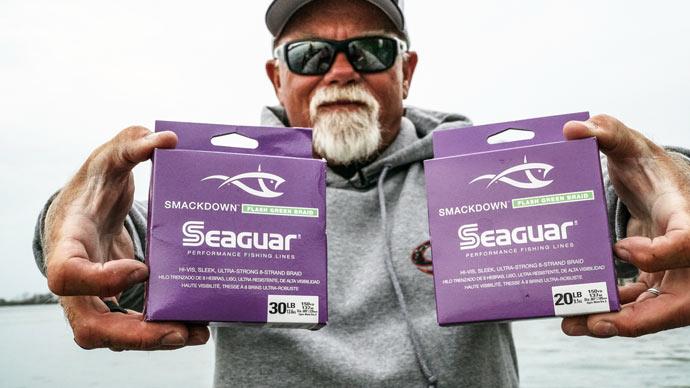
For those anglers who pride themselves on being filled in on the latest and greatest in fishing tackle, fluorocarbon fishing line will probably be an old hack. Still, for the majority of the bass fishing population, this new breed of the line may be something of a mystery.
Though new to the bass fishing scene, fluorocarbon line has been commonplace for years on the spools of saltwater flats anglers targeting line-shy fish, as well as fly fishermen who pursue various elusive trout species. This, due impart to its near-complete invisibility once underwater. This near invisibility, its claim to fame, comes from the line made with a fluorocarbon resin. Fluorocarbon has nearly the same light refraction rate as water, explaining how it "disappears" once beneath the surface. Understand that while this seems like the ultimate advantage over the fish, there are applications where it's an advantage and applications where it might be a disadvantage.
Several brands on the market proclaim themselves as fluorocarbon line, though let it be known not all of them are made from one hundred percent fluorocarbon. The line I use and swear by is produced by P-Line and is produced with one hundred percent fluorocarbon. Despite this, it does handle well as a fishing line in general. The handling is a reason some anglers might shy away from fluorocarbon.
Though initially prone to more line memory problems than traditional monofilament or braid lines, that is no longer an issue. Most of the situations I will discuss as far as applications for this line require a spinning outfit, which today's fluorocarbon lines are excellent choices. That wasn't the case back when it was introduced decades ago.
Fluorocarbon should be used whenever stealth and a subtle presentation are needed or preferred. This means that while having the line invisible all of the time might seem like a good idea, using this stuff when flipping jigs into timber would be likened to swatting flies with a Scud missile, in a word: pointless. Finesse fishing is really where this line comes into its own.
In the past, anglers would go out of their way to cut down on line size, reduce entry noise and make the bait look as natural as possible. But still, regardless of what they did, there would be a considerable line signature coming out of the bait. Now, with the aid of fluorocarbon fishing lines, in addition to having a very natural-looking bait, you lose the one thing that could ruin a presentation, that being the line signature. It should be noted that aside from being invisible, there is a more significant bonus to using fluorocarbon in a finesse application. Now that your line is invisible, you can use considerably heavier line weights, which takes away the thing many bass anglers dread using finesse techniques: ultra-light line.
Another application for fluorocarbon line, which is certainly not new in any way, shape, or form, is used as leader material. When probing deep structure for finicky, passive bass, the invisible line on a Carolina rig is a great plus and will most likely get much more fish in the boat as a result. Fluorocarbon fishing line has distinctive handling characteristics, different from monofilament. As a result, some anglers who adapt to such characteristics use fluorocarbon as a leader all the time, regardless of presentation style. Usually, this requires using a blood knot to join the mono with the fluorocarbon line and is fished as per usual.
On a final note, I have recently discovered another tactic that extensively exploits the sound characteristics of fluorocarbon lines. Using the line with a drop shot rig makes for a fantastic presentation in and of itself. I have experimented with this presentation with this line in a swimming pool, and to say it's impressive would be an understatement. Those who know what the drop shot rig is and what it looks like probably have a good mental picture of what I'm talking about. Stay tuned for those who don't; I'm sure I'll have an article on the technique soon enough.
In the meantime, there are plenty of other places to learn of its advantages and uses. As mentioned before, when presented in the pool, the worm appears to hover in place, with no line leading to or away from the bait. Though I haven't tried this rig out on an actual lake yet, I plan to and can only imagine its effectiveness on heavily pressured water that takes a regular beating from anglers throwing more traditional rigs. Again, the point here is to show how a minor modification, the line, in this case, can take a very effective rig and improve it to a potential tournament winner.
With that said, I urge every angler to give fluorocarbon fishing line a shot and see what it can do to new techniques and some other tried and proper techniques that we all use every time we hit the water. In many cases, the lack of line signature and the overall increase in the realism factor of the bait may be the determining factor of putting more bass in your boat.
Catch you on the water...




